This post is going to be about the ethical harvesting of a rooster. There are going to be photos along with detailed instructions on the process.
If you want to read about it, click on the “more…” button. If you’d rather skip it, that’s fine, tomorrow I’ll start telling some of the many stories I collected while attending the Northeastern Poultry Congress (and one of those stories is about becoming a mama hen to a new baby chick.)
For those who choose not to read the rest of this rooster killing post, I’ll leave you these parting words… it’s wasn’t as bad as we had imagined it would be.
The Ethical killing of a rooster. Let me begin with the fact that it’s not fun. Killing anything is not fun and (yeah, I’m the sort of person who feels bad about killing bugs, if I can move them outdoors I do) but if you are going to be a responsible backyard chicken owner who has neighbors, then something needs to be done.
I can think of no quicker way for towns to revoke the right to have chickens in your backyard than to have a group of anti-rooster-noise people gathered together in protest. Although I firmly believe that you have a right to own chickens in your backyard, I also believe that neighbors have a right to some peace and quiet and while a crowing rooster during the day is rather bucolic, one that is crowing at 2 or 3 in the morning is, well, NOT.
We’ve tried very hard to not have roosters, but sometimes they slip in. Our first few roosters were when we bought some exotic chicks. We thought the smaller, more petite, ones would be females. We were almost right, but out of 6 chicks we ended up with 2 roosters. Not very good odds.
We’ve bought sex-linked birds in an effort to keep roosters out but if you take that one step back, by buying the sex-linked birds, you are just destroying the roosters earlier (the wrong color chicks are destroyed right after birth.)
Last Summer we hatched eggs in an incubator. We got a few roosters. It happens. I even talked to a woman at the Northeastern Poultry Congress who told me she knew of someone who had ordered pullets and somehow a rooster got into the order.
My point is that you can be as conscientious as you want, but occasionally if you decide to have chickens, you are probably going to have a rooster at one point or another and you are going to have to figure out what to do with them.
I spoke to one woman at the Congress who said that if her neighbors dogs’ barked (and they did) then that gave her a right to have roosters who crowed. While on some level that reasoning is correct, I’m also thinking that might not be a very happy neighborhood.
Our most mature rooster (and therefore the alpha, protector, and noisiest of our birds) was a problem, he was making a lot of noise. As handsome as he was, he had to go.
We had talked about chopping the head off with an ax but didn’t know how to secure the head so that we’d be assured a clean cut. The kids had visions of missing and nicking the bird, I had visions of taking a trip to the emergency room. We talked about building a block with belts on it to hold the bird down but we quickly dismissed that because we thought we’d be terrorizing the bird for too long just to get it ready.
So I bought something called a Killing Cone. It looks like a large galvanized steel waffle cone. I’ve include a photo of ours here. (Just as an aside here, I bought the cone at the Poultry Congress which is all about celebrating chickens, so after I got it, I discretely and quickly took it out to my car for the rest of the time I was at the show.) I bought a size medium which fits a bird up to 20 pounds, as my rooster was a roughly 3-4 pound 6 month old, I was sure he would fit. The price for our cone was 19.95 and I got it at the Eggcarton.com booth (and can I say that they were incredibly helpful by giving me encouraging information for the process.)
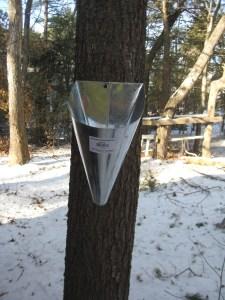
After watching a few videos, we were ready.
These are the steps we took:
- Nailed the Killing Cone to a tree far away from and out of view of the hen house. You want the height to be at a level where you can stand comfortably to be able to do the kill. If you are bending over or have to reach up high, it increases the risk that you won’t get a clean kill.
- Placed a bucket directly under the cone to catch the blood from the kill. (and there will be a fair amount of blood, I was surprised.)
- Got the rooster. I carried him and talked to him apologizing for this as I brought him over. There is discussion that the roosters should be carried to the cone by the feet because that increases blood to the head area but I think that that’s unnecessary trauma so I carried him. (also, remember, this is the first time we’ve ever harvested a chicken and yeah, I did have to deal with a few feelings of guilt.)
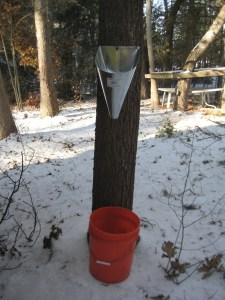
The next part has to be done quickly, so make sure you have your (very sharp – we used a hunting one) knife ready, everything is in place, and that you have gloves on. The gloves are not only because you’ll get some blood on your hands, but I also didn’t want the chance of the other chickens smelling chicken blood on us.
- Place the bird in the cone feet facing toward you.
- Pull the head out of the bottom of the cone.
- As you bring the knife to the carotid artery (located just below the ear) bring your knife up under the feathers so that you are cutting skin and are not sawing through feathers.
- A quick deep cut is all you need. (although for us it took a few swipes before we could find the right area – remember this was our first time.)
- The chicken will bleed out fairly quickly (in a matter of 4 -5 minutes) as he bleeds out, you can see his eyes slowing closing. Not to minimize this at all, but it looked like our bird was slowly going to sleep.
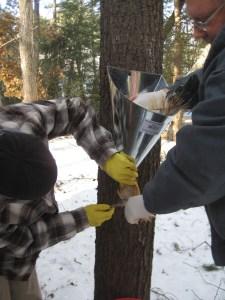
When the bird has bled out, and is no longer alive, take the body out of the cone and either dip it in hot water to start the process of getting rid of the feathers to prepare the carcass for eating (which we did not do) or bring the carcass to the woods and let the local wildlife feast on it (which is what we did making sure to place it well off the trail so that no person would come across it.)
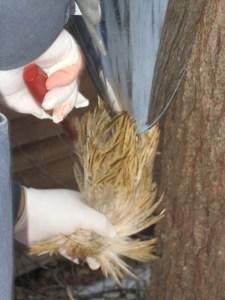
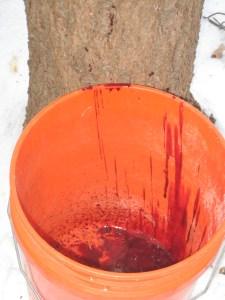
That’s it. There was more worry, and angst involved then there was action, and when all was said and done it wasn’t as bad as we thought it would be.
A few thoughts:
- The cone helps to “disguise” the body a little allowing you a tiny bit of emotional distance.
- Amazingly our rooster never struggled (and I mean never.) He didn’t squawk, he didn’t try to escape, once he was in the cone there was no noise, this wasn’t about us, but it sure makes it easier if the animal you are about to kill doesn’t put up a struggle.
- We decided on a quick bleed-out as opposed to chopping the head off for a few reasons, a bleed-out is slower but gentle. It’s as if, we literally put our bird to sleep. An ax was just too violent for us, none of us wanted to deal with a chicken running around with it’s head cut off.
- The blood (and there is quite a bit) was taken out to the woods far from the hen house (and from where people walk) and was dumped. We had discussed putting it into the river that runs along side our street and may do that in the future but not with all the ice around, just don’t need people to see puddles of frozen blood until the spring.
The deed is done. Now we know that we can do it and it’s not the end of the world and although I’ll never look forward to doing this again, at least in the future, we know that if we have to, we’ll be able to.

